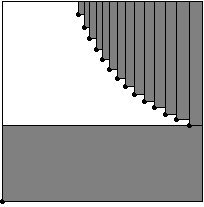Anchored Rectangles
Suppose we want to pack a unit square with non-overlapping rectangles that have sides parallel to the axes. The catch is that the lower left corners of all the rectangles are given. By the way, such rectangles are called anchored. Now, given some points in the unit square, aka the lower left corners, we want to find anchored rectangles with the maximum total area.

When the given points are close to the right upper corner of the square, the total area is small. When a single point is in the bottom left corner of the square, we can cover the whole square. The problem becomes more interesting if we add one extra assumption: one of the given points has to be the bottom left corner of the square. In the 1960’s, it was conjectured by Allen Freedman that any set of points has an anchored rectangle packing with the area of at least one half. The problem is quite resistant. In 2011, Dumitrescu and Tóth showed that every set of points has a packing of area at least 0.09, which was the first constant bound found, and is the best bound currently known.
I gave this problem to my PRIMES student Vincent Bian. He wrote a paper, Special Configurations in Anchored Rectangle Packings, that is now available at the arxiv. When you look at this problem you see that the number of ways to pack depends on the relative coordinates of the points. That means you can view the points as a permutation. Vincent showed that the conjecture is true for several different configurations of points: increasing, decreasing, mountain, split layer, cliff, and sparse decreasing permutations.
An increasing permutation is easy. There are two natural ways to pack the rectangles. One way, when rectangles are horizontal and each rectangle reaches to the right side of the square (see picture above). Another way, when rectangles are vertical. When you take the union of both cases, the square is completely covered, which means at least one of the cases covers at least half of the square. The worst case scenario, that is, the case when the maximum possible area is the smallest is when your points are placed equidistantly on the diagonal.

Other cases are more difficult. For example, Vincent showed that for a decreasing permutation with n points, the worst case scenario is when the points are arranged equidistantly on a hyperbola xy = (1-1/n)n. The picture shows the configuration for 15 points. The total area is more than one half.
Share:
Leave a comment